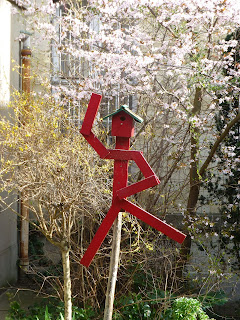Last week I shared some photos of the grounds of Saint Anne's Hospital, which was Beauford's last residence prior to his death.
Saint Anne's provides cutting edge therapy in the fields of psychiatry and neuroscience today. I want to share some information about the institution's history and its current status within the city of Paris with you in this post.
Insignia - Saint Anne's Hospital
© Discover Paris!
The Centre Hospitalier Sainte Anne is built on land that has served as a hospital since the 13th century. Marguerite de Provence, wife of King Louis IX (Saint Louis) had a "health house" (maison de santé) constructed on the property. Anne d'Autriche, wife of Louis XIII and mother of the "Sun King," Louis XIV, built the first true hospital here. The current facility owes its name to her - it was originally called Saint Anne's farm.
In 1863, Napoleon III decided that a psychiatric hospital should be built here. He assigned the edification of the facility to Baron Haussmann, the same man who is largely responsible for Paris' current urban design. Haussmann placed architect Charles-Auguste Questel in charge of the project and work proceeded over a period of four years. Most of the buildings that were put into service in 1867 still exist and constitute the architectural patrimony of the hospital.
Questel's original layout
© Discover Paris!
Saint Anne's was inscribed on the list of historical monuments in France on November 26, 1979, just over a month before Beauford died.
The campus covers 13 hectares (32 acres), with over seven hectares (17 acres) of protected green space.
Courtyard flanked by trees and flower beds
© Discover Paris!
The principal thoroughfare is being renovated to respect as much of Questel's original layout as possible: on site parking is being minimized; flower beds, gardens, and esplanades are being re-established; and original ground cover is being restored.
Over 40 "remarkable trees," complete with signage that presents genus, species, and land of origin, dot the campus and dozens of new trees are scheduled to be planted. Over 10 botanical trails are envisioned as well.
Bird house and flowering trees
© Discover Paris!
A small public park can be found near the main entrance on rue Cabanis.
Parc Charles Baudelaire
© Discover Paris!
The most attractive views of buildings and the best piece of sculpture on the grounds can be found in the Cour Maurice Ravel.
View of Cour Maurice Ravel
© Discover Paris!
New buildings (including social housing) are being constructed, but they are relegated to the periphery of the campus. The older buildings are being completely refurbished inside so that the facilities are completely modern.
Pavilion Benjamin Ball under restoration
© Discover Paris!
All aspects of the design are being undertaken with the intent to maintain Saint Anne's as an integral part of the fabric of the surrounding neighborhood.
Click on the link below to read the first post about Saint Anne's Hospital:
Beauford's Paris: Saint Anne's Hospital - Part 1
Saint Anne's provides cutting edge therapy in the fields of psychiatry and neuroscience today. I want to share some information about the institution's history and its current status within the city of Paris with you in this post.
© Discover Paris!
The Centre Hospitalier Sainte Anne is built on land that has served as a hospital since the 13th century. Marguerite de Provence, wife of King Louis IX (Saint Louis) had a "health house" (maison de santé) constructed on the property. Anne d'Autriche, wife of Louis XIII and mother of the "Sun King," Louis XIV, built the first true hospital here. The current facility owes its name to her - it was originally called Saint Anne's farm.
In 1863, Napoleon III decided that a psychiatric hospital should be built here. He assigned the edification of the facility to Baron Haussmann, the same man who is largely responsible for Paris' current urban design. Haussmann placed architect Charles-Auguste Questel in charge of the project and work proceeded over a period of four years. Most of the buildings that were put into service in 1867 still exist and constitute the architectural patrimony of the hospital.
© Discover Paris!
Saint Anne's was inscribed on the list of historical monuments in France on November 26, 1979, just over a month before Beauford died.
The campus covers 13 hectares (32 acres), with over seven hectares (17 acres) of protected green space.
© Discover Paris!
The principal thoroughfare is being renovated to respect as much of Questel's original layout as possible: on site parking is being minimized; flower beds, gardens, and esplanades are being re-established; and original ground cover is being restored.
Over 40 "remarkable trees," complete with signage that presents genus, species, and land of origin, dot the campus and dozens of new trees are scheduled to be planted. Over 10 botanical trails are envisioned as well.
© Discover Paris!
A small public park can be found near the main entrance on rue Cabanis.
© Discover Paris!
The most attractive views of buildings and the best piece of sculpture on the grounds can be found in the Cour Maurice Ravel.
© Discover Paris!
New buildings (including social housing) are being constructed, but they are relegated to the periphery of the campus. The older buildings are being completely refurbished inside so that the facilities are completely modern.
© Discover Paris!
All aspects of the design are being undertaken with the intent to maintain Saint Anne's as an integral part of the fabric of the surrounding neighborhood.
Click on the link below to read the first post about Saint Anne's Hospital:
Beauford's Paris: Saint Anne's Hospital - Part 1










No comments:
Post a Comment